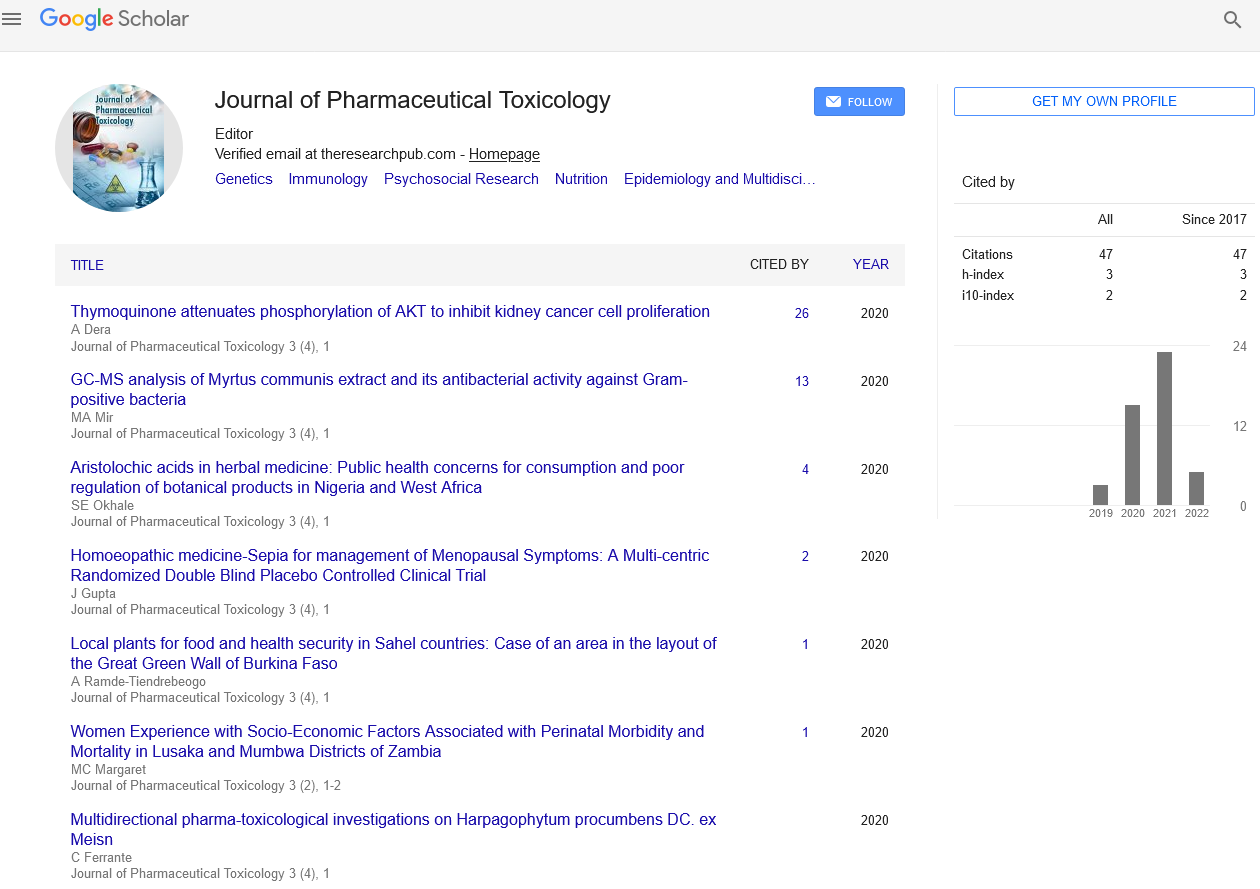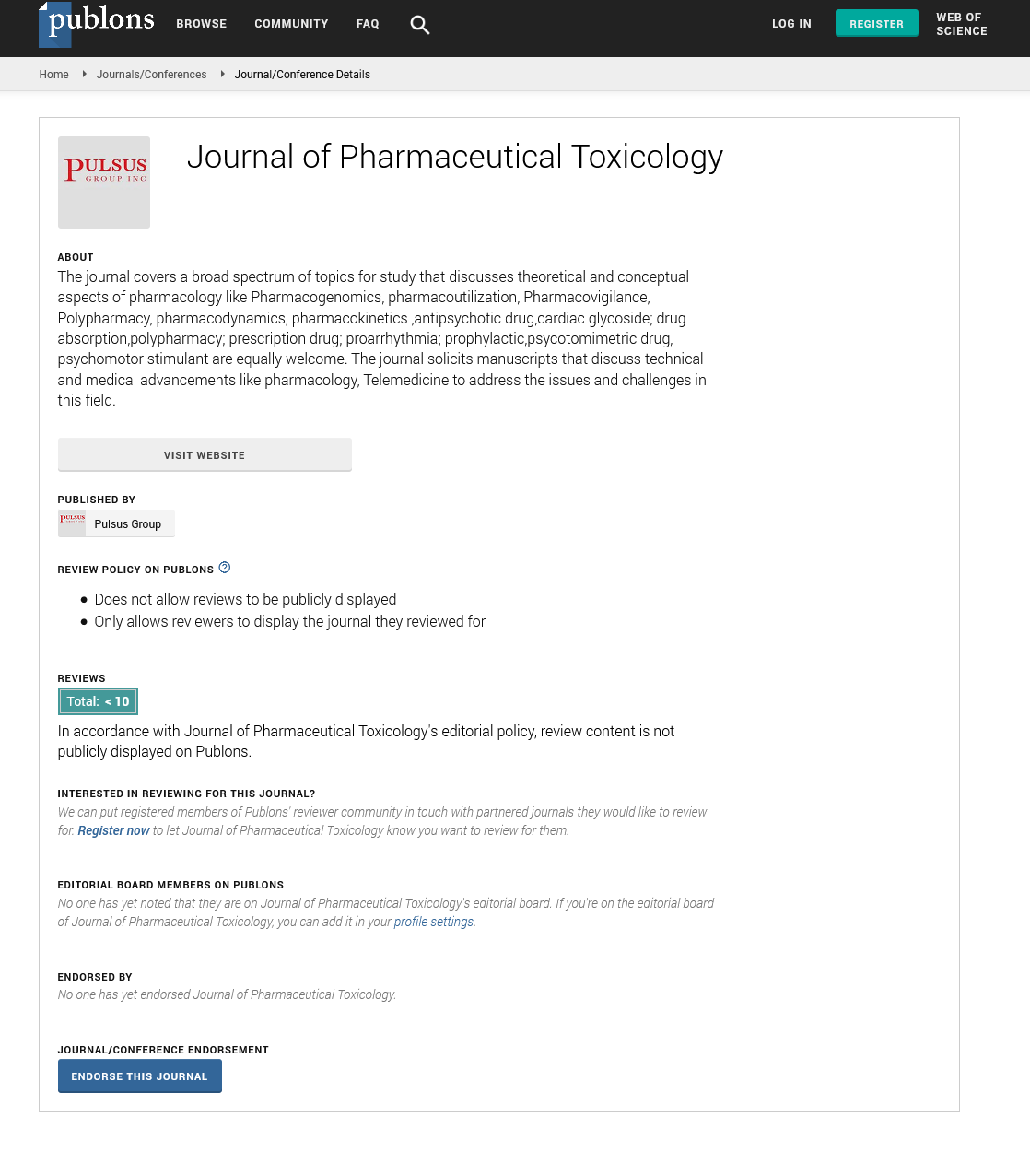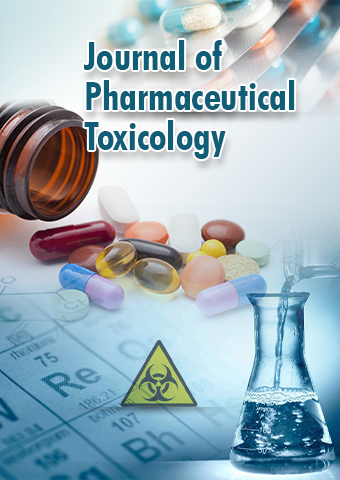Research Article - Journal of Pharmaceutical Toxicology (2023) Volume 6, Issue 2
The Role of Pharmacology in Modern Medicine: From Drug Discovery to Clinical Applications
Robert Ronald*
Department of Medicine and Therapeutics, The Chinese University of Hong Kong, Prince of Wales Hospital, Shatin, Hong Kong, China
Department of Medicine and Therapeutics, The Chinese University of Hong Kong, Prince of Wales Hospital, Shatin, Hong Kong, China
E-mail: robertronald89@gmail.com
Received: 03-April-2023, Manuscript No. jpt-23-94553; Editor assigned: 5-April-2023, PreQC No. jpt-23-94553 (PQ); Reviewed: 19-April-2023, QC No. jpt-23-94553; Revised: 21-April-2023, Manuscript No. jpt-23- 94553 (R); Published: 28-April-2023 DOI: 10.37532/jpt.2023.6(2).36-39
Abstract
Pharmacogenomics is an emerging field that combines pharmacology and genomics to create personalized medication regimens based on a patient’s genetic profile. By analyzing an individual’s DNA, pharmacists can predict how they will respond to certain drugs, identify potential adverse reactions, and tailor treatment accordingly. This article will explore the science behind pharmacogenomics, its potential applications in pharmacy practice, and the ethical considerations surrounding genetic testing and personalized medicine. The United States is in the midst of an opioid epidemic, with millions of people addicted to prescription painkillers and illicit drugs like heroin and fentanyl. Pharmacists play a crucial role in preventing and managing opioid abuse, from monitoring prescription drug databases to providing naloxone overdose reversal kits. This article will examine the scope of the opioid crisis, the role of pharmacists in addressing it, and the challenges they face in balancing patient care with opioid safety and addiction prevention
Keywords
Clinical trial • Protocol compliance • Protocol deviation • Nurse • Nursing management Evidence-based
Introduction
Pharmacology has numerous clinical applications, including the treatment of diseases such as cancer, cardiovascular disease, and neurological disorders. It is also used in the prevention and treatment of infectious diseases, as well as in pain management and anesthesia. Additionally, pharmacology plays a crucial role in drug safety and drug interactions. Adverse drug reactions (ADRs) are unwanted or harmful effects of drugs. They can range from mild to severe and can be caused by a variety of factors, including drug interactions, patient characteristics, and doserelated toxicity. Pharmacovigilance is the process of monitoring and reporting ADRs to ensure drug safety [1].
Pharmacogenomics is the study of how genetic variations affect drug response. By understanding the genetic basis of drug response, healthcare providers can tailor drug therapies to individual patients, optimizing efficacy and minimizing ADRs. Pharmacology plays a vital role in modern medicine, from drug discovery to clinical applications. Its importance in drug development, drug safety, and personalized medicine cannot be overstated. As our understanding of the mechanisms of drug action and drug interactions continues to evolve, so too will the role of pharmacology in medicine. Pharmacology is the study of how drugs interact with biological systems to produce therapeutic effects. It is a vast field that encompasses the study of various drugs, their effects on the human body, and the mechanisms by which they work [2]. The history of pharmacology dates back to ancient times when humans first discovered the healing properties of plants and herbs. However, with advances in modern medicine, pharmacology has become a highly specialized field that requires a deep understanding of biochemistry, physiology, and pharmacokinetics.
This article will explore the fascinating world of pharmacology, from the history of drugs to the latest advancements in the field. We will also discuss the different classes of drugs, their modes of action, and their therapeutic applications. The history of pharmacology can be traced back to the ancient Egyptians, who used plants and herbs to treat various ailments [3]. The Greeks also made significant contributions to the field, with Hippocrates, the father of medicine, documenting the therapeutic properties of plants and herbs. During the middle Ages, the use of plants and herbs for medicinal purposes became widespread, with the establishment of botanical gardens and the publication of numerous herbals. However, it was not until the 19th century that modern pharmacology began to emerge as a distinct discipline.
In the 19th century, chemists began to isolate and synthesize various compounds from natural sources, leading to the development of new drugs. The discovery of the first modern drug, morphine, in 1804, revolutionized the treatment of pain. Other significant developments during this period included the discovery of quinine, which was used to treat malaria, and the development of aspirin, which is still widely used today as a pain reliever. The 20th century saw significant advancements in pharmacology, with the development of antibiotics, antiviral drugs, and other life-saving medications. The discovery of insulin in 1921 revolutionized the treatment of diabetes, while the development of penicillin in 1928 marked the beginning of the antibiotic era.Today, pharmacology is a rapidly evolving field that continues to make significant contributions to medicine and healthcare [4].
Discussion
There are numerous classes of drugs, each with its unique mode of action and therapeutic application. The following are some of the most commonly used classes of drugs. Analgesics: Analgesics are drugs that are used to relieve pain. They work by blocking the transmission of pain signals to the brain, thereby reducing the perception of pain. Examples of analgesics include opioids, such as morphine, and nonopioid drugs, such as acetaminophen and ibuprofen.
Antidepressants: Antidepressants are drugs that are used to treat depression and other mood disorders. They work by increasing the levels of certain neurotransmitters, such as serotonin and norepinephrine, in the brain. Examples of antidepressants include selective serotonin reuptake inhibitors (SSRIs) and tricyclic antidepressants (TCAs). Antihypertensives are drugs that are used to lower blood pressure. They work by relaxing the blood vessels, thereby reducing the resistance to blood flow. Examples of antihypertensives include diuretics, betablockers, and ACE inhibitors. Antipsychotics: Antipsychotics are drugs that are used to treat psychosis, such as schizophrenia. They work by blocking the dopamine receptors in the brain, thereby reducing the symptoms of psychosis. Examples of antipsychotics include chlorpromazine and risperidone [5]. The field of pharmacology is the study of how drugs interact with the body to produce a therapeutic effect. It encompasses the scientific study of the properties, actions, and effects of drugs on biological systems, as well as the discovery, development, and evaluation of new drugs for the treatment of disease. Pharmacology is a constantly evolving field, with new drugs and treatments being developed all the time. In this article, we will explore the development of pharmacology, from its origins in folk remedies to modern medicine.
The use of plants and other natural substances for medicinal purposes can be traced back to ancient times. Many cultures around the world have traditional remedies that are still used today, such as traditional Chinese medicine, Ayurvedic medicine from India, and the traditional medicine of many indigenous peoples. The use of plant-based medicines has a long history in Europe as well. The Greek physician Hippocrates, who lived in the 5th century BCE, is often referred to as the “father of medicine” and is credited with introducing the concept of using plants for medicinal purposes. In the centuries that followed, many other Greek and Roman physicians continued to explore the properties of plants and their potential medicinal uses.
In the middle Ages, the use of medicinal plants became more widespread in Europe. Monks and other members of religious orders often maintained gardens where they grew medicinal plants for use in treating the sick. The use of herbal remedies also became more common among the general population, with people relying on traditional remedies passed down through generations. The scientific revolution of the 17th century brought about a new era in the study of medicine and pharmacology. As scientists began to explore the natural world in a more systematic way, they began to develop new methods for studying the properties and effects of drugs [6].
One of the key figures in the development of modern pharmacology was the Swiss physician Paracelsus, who lived in the 16th century. Paracelsus rejected many of the traditional beliefs about medicine and instead emphasized the importance of empirical observation and experimentation. He also introduced the idea of using specific chemical compounds for medicinal purposes, rather than relying on whole plants or other natural substances. In the centuries that followed, scientists continued to make important discoveries in the field of pharmacology. In the 19th century, the German chemist Friedrich Serturner isolated morphine, the first alkaloid to be discovered. This led to the development of other powerful painkillers, such as codeine and oxycodone.
At the same time, scientists were beginning to explore the properties of synthetic compounds. One of the earliest synthetic drugs was salicylic acid, which was first synthesized in the mid-19th century. Salicylic acid was later modified to create acetylsalicylic acid, better known as aspirin. The 20th century saw rapid advancements in the field of pharmacology. New drugs were being developed at an unprecedented rate, and the process of drug discovery and development became increasingly sophisticated [7].
One of the most important developments in modern pharmacology was the use of randomized controlled trials (RCTs) to evaluate the safety and efficacy of new drugs. RCTs involve randomly assigning participants to receive either the new drug or a placebo, and then comparing the outcomes between the two groups. This method provides a rigorous scientific basis for evaluating new drugs, and has become the gold standard for drug development. Pharmacology is the study of how drugs interact with living organisms to produce therapeutic effects. It is a crucial field that has been around since ancient times. Over the years, pharmacology has evolved, and today, it is an integral part of modern medicine. In this article, we will explore the evolution of pharmacology from ancient times to modern medicine.
The use of plants as medicine can be traced back to ancient civilizations. In ancient Egypt, for example, plant-based remedies were used to treat various illnesses. The Ebers Papyrus, an ancient Egyptian medical document, contains over 700 remedies, many of which were plantbased. Similarly, the ancient Greeks used plantbased remedies. Hippocrates, often referred to as the father of modern medicine, believed that nature provided all the medicines needed to treat illnesses. He used various plant-based remedies to treat his patients [8].
During the middle Ages, the use of plant-based remedies continued. However, this period also saw the rise of alchemy, a precursor to modern chemistry. Alchemists sought to turn base metals into gold and to find a universal panacea, a substance that could cure all diseases. While alchemy did not achieve its lofty goals, it did contribute to the development of modern pharmacology. Alchemists discovered new substances, some of which were used as medicines [9].
The birth of modern pharmacology can be traced back to the 19th century. In 1804, Friedrich Wilhelm Serturner isolated morphine from opium, a substance that had been used for thousands of years for pain relief. Morphine quickly became a popular painkiller, but its addictive properties soon became apparent. In the late 19th century, chemists began to synthesize new drugs in the laboratory. This led to the development of drugs such as aspirin, which was synthesized in 1899. The 20th century saw a rapid expansion of pharmacology. The discovery of penicillin in 1928 by Alexander Fleming revolutionized the treatment of bacterial infections. Other important drugs were also discovered during this period, including insulin, which was first isolated in 1921, and cortisone, which was first synthesized in 1948 [10].
Conclusion
Pharmacology is an integral part of modern medicine. Drugs are used to treat a wide range of illnesses, from infections to cancer. In some cases, drugs can even cure diseases. For example, antibiotics can cure bacterial infections, and antiviral drugs can cure some viral infections. Pharmacology is also important in the development of new drugs. Before a new drug can be approved for use, it must undergo rigorous testing to ensure that it is safe and effective. This testing is done in phases, starting with preclinical studies and progressing to clinical trials involving human subjects.
The development of new drugs became more systematic, and new methods for testing drugs were developed. The introduction of computeraided drug design in the 1980s allowed for the rapid screening of potential drug candidates. This has led to the development of many important drugs, including statins, which are used to lower cholesterol levels, and antiretroviral drugs, which are used to treat HIV. Modern pharmacology is a complex and interdisciplinary field. It involves the study of how drugs interact with living organisms at the molecular and cellular levels. It also involves the study of drug metabolism, pharmacokinetics, and pharmacodynamics.
Acknowledgement
I would like to thank my professor for his support and encouragement.
Conflict of Interest
The authors declare that there is no conflict of interest.
References
- Sun J, He WT, Wang L et al. COVID-19: epidemiology, evolution, and cross-disciplinary perspectives. Trends Mol Med. 26,483 (2020).
- Li Q, Guan X, Wu P et al. Early transmission dynamics in Wuhan, China, of novel coronavirus-infected pneumonia. NEJM. 382,1199-1207 (2020).
- Mohebali M. Visceral leishmaniasis in Iran: review of the epidemiological and clinical features. Iran J Parasitol. 8:348-358 (2013).
- Mohebali M, Hajjaran H, Hamzavi Y et al. Epidemiological aspects of canine visceral leishmaniosis in the Islamic Republic of Iran. Vet Parasitol. 129,243-251 (2005).
- Shafiei R, Mohebali M, Akhoundi B et al. Emergence of co-infection of visceral leishmaniasis in HIV-positive patients in northeast Iran. Travel Med Infect Dis. 12,173-178 (2014).
- Topno RK, Das VNR, Ranjan A et al. Asymptomatic infection with visceral leishmaniasis in a disease-endemic area in Bihar, India. Am J Trop Med Hyg. 83,502-506 (2010).
- Zhou P, Liu Z, Chen Y et al. Bacterial and fungal infections in COVID-19 patientsn. Infect Control Hosp Epidemiol. 41,1124-1125 (2020).
- Viney ME, Graham AL. Patterns and processes in parasite co-infection. Adv Parasitol. 82,321-369 (2013).
- Sundar S, Rai M. Laboratory diagnosis of visceral leishmaniasis. Clin Vaccine Immunol. 9,951-958 (2002).
- Dalgiç B, Dursun I, Akyol G et al. A case of visceral leishmaniasis misdiagnosed as autoimmune hepatitis. Turk J Gastroenterol. 16,52-53 (2005).
Google Scholar, Crossref, Indexed at
Google Scholar, Crossref, Indexed at
Google Scholar, Crossref, Indexed at
Google Scholar, Crossref, Indexed at
Google Scholar, Crossref, Indexed at
Google Scholar, Crossref, Indexed at
Google Scholar, Crossref, Indexed at
Google Scholar, Crossref, Indexed at


